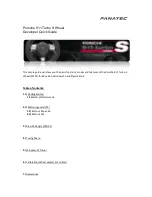
Active Safety Features
These Active Safety features are designed to increase
your safety:
• Lane Assist (see
)
• Collision Avoidance Assist (see
• Speed Assist (see
You can enable/disable some of these features and in
some cases, control how they work. To access settings
for these features, touch
Controls
>
Autopilot
.
Autopilot Features
NOTE:
Depending on market region, vehicle
configuration, options purchased, and software version,
your vehicle may not be equipped with all features listed
below, or a feature may not operate exactly as
described.
These Autopilot convenience features are designed to
reduce driver workload:
• Traffic-Aware Cruise Control (see
• Autosteer (see
• Auto Lane Change (see
• Autopark (see
• Summon (see
)
• Stop Light and Stop Sign Warning (see
and Stop Sign Warning on page 105
• Navigate on Autopilot (see
• Traffic Light and Stop Sign Control (see
and Stop Sign Control on page 109
)
You can enable/disable some of these features and in
some cases, control how they work. To access settings
associated with these features, touch
Controls
>
Autopilot
.
Drive to Calibrate Cameras
Model X must maneuver with precision when Autopilot
features are being used. Therefore, before some features
can be used for the first time or after some types of
service repairs, cameras must complete a self-calibration
process. For your convenience, the instrument panel
displays a progress indicator.
When calibration is complete, Autopilot features are
available for use. Calibration typically completes after
driving 32-40 km, but the distance varies depending on
road and environmental conditions. For example,
calibration completes quicker when driving on a straight
road with multiple lanes (such as a controlled-access
highway), with highly-visible lane markings (in the
driving lane as well as the adjacent lanes). Contact Tesla
only if your Model X has not completed the calibration
process after driving 160 km in the described conditions.
If a camera has shifted from its calibrated position (for
example, the camera or windshield was replaced), you
must clear the calibration. To do so, touch
Controls
>
Service
>
Camera Calibration
>
Clear Calibration
. When
the calibration is cleared, Model X repeats the calibration
process. While this helps re-calibrate the cameras in
many cases,
Clear Calibration
may not resolve all
camera and sensor concerns.
NOTE:
The self-calibration drive process is only
applicable to Model X vehicles built after approximately
October 12, 2016.
NOTE:
To calibrate, cameras require highly-visible lane
markings in both the driving lane and adjacent lanes (at
least two lanes over on each side of the vehicle). For
best results, drive in the middle lane of a multi-lane
highway (ideally with at least five lanes) that has clear
lane markings and minimal traffic.
NOTE:
If you attempt to use a feature that is not
available until the calibration process is complete, the
feature is disabled and the instrument panel displays a
message.
NOTE:
Model X must repeat the calibration process if
the cameras are serviced by Tesla, and in some cases,
after a software update.
Limitations
Many factors can impact the performance of Autopilot
components, causing them to be unable to function as
intended. These include (but are not limited to):
• Poor visibility (due to heavy rain, snow, fog, etc.).
• Bright light (due to oncoming headlights, direct
sunlight, etc.).
• Damage or obstructions caused by mud, ice, snow,
etc.
• Interference or obstruction by object(s) mounted
onto the vehicle (such as a bike rack).
• Obstruction caused by applying excessive paint or
adhesive products (such as wraps, stickers, rubber
coating, etc.) onto the vehicle.
• Narrow or winding roads.
• A damaged or misaligned body panel.
• Use of gray or aftermarket glass.
• Interference from other equipment that generates
ultrasonic waves.
About Autopilot
95
Autopilot
















































